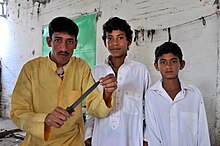
Back رشايدة Arabic Raixaida Catalan Rashaida German Raŝajdaoj Esperanto Rashaidat Finnish Rashaida French רשאידה HE Rashaida Croatian Rasyaidah ID Rashaida Italian
 Rashaida boys with their father near Kassala in Eastern Sudan | |
| Total population | |
|---|---|
| 170,000-360,000 | |
| Regions with significant populations | |
| Red Sea coastal plains | |
| 187,500[1] | |
| 168,000[1] | |
| Languages | |
| Hejazi Arabic,[2] Sudanese Arabic | |
| Religion | |
| Sunni Islam | |
| Related ethnic groups | |
| Arabs[3] | |
The Rashaida (Arabic: رشايدة), also known as Bani Rasheed, are an ethnic group inhabiting the coastal plain of the Red Sea stretching from the Sudanese city of Port Sudan to the Eritrean city of Massawa.[4] They are the descendants of Arab tribes people from Hejaz, who fled the Arabian peninsula in 1846 as the Saudis rose to power.[5] They are mostly nomadic and constitute 187,500 people in Eritrea and 168,000 people in Sudan, mainly in the eastern part around Kassala.[1]
Across Eritrea and Sudan, the Rashaida keep their traditional dress, culture, customs, camel breeds and practice of Sunni Islam.[6][7] In Eritrea, Rashaida people are commonly confused with Adeni Arabs, a small group of about 18,000 Arabs from Aden, who tend to cohabit similar regions as the Rashaida. Although Adeni Arabs originally hail from Yemen and tend to live in a more geographically concentrated area of Eritrea, mainly in the port city of Massawa, Rashaida people tend to live along the Red Sea Coast from Massawa Eritrea to Port Sudan Sudan and to the Sinai in places as far north as Egypt.[8]
The Rashaida have been involved in human trafficking and later the refugee kidnappings in Sinai.
- ^ a b c Fadlalla, Mohamed (July 2005). The Problem of Dar Fur. iUniverse. p. 20. ISBN 978-0-595-36502-9.
- ^ "Rashaida people, Hejaz, Bani Rasheed". Retrieved 1 June 2023.
- ^ Agius, Dionisius A. (2012). "The Rashayda: Ethnic Identity and Dhow Activity in Suakin on the Red Sea Coast". Northeast African Studies. 12 (1): 169–216. doi:10.2307/41960562. JSTOR 41960562.
- ^ Young, William C., "The Rashaayda Bedouin - Arab Pastoralists of Sudan", 1996.
- ^ Connell, Dan; Killion, Tom (2010-10-14). Historical Dictionary of Eritrea. Scarecrow Press. p. 438. ISBN 978-0-8108-7505-0.
- ^ Snap Shots Archived 2006-11-02 at the Wayback Machine, Al-Ahram Weekly, 29 December 2005 - 4 January 2006, Issue No. 775
- ^ Cite error: The named reference
:8was invoked but never defined (see the help page). - ^ "The Adeni Arabs of Eritrea".
© MMXXIII Rich X Search. We shall prevail. All rights reserved. Rich X Search